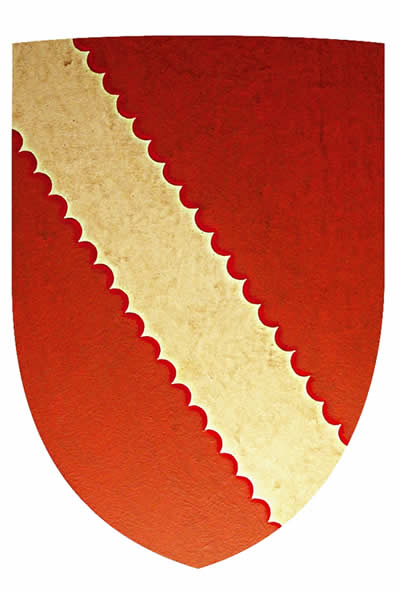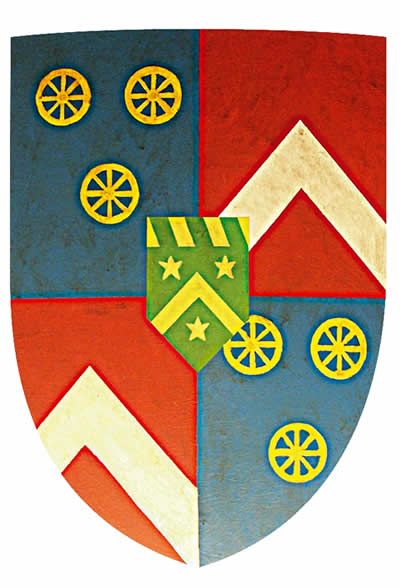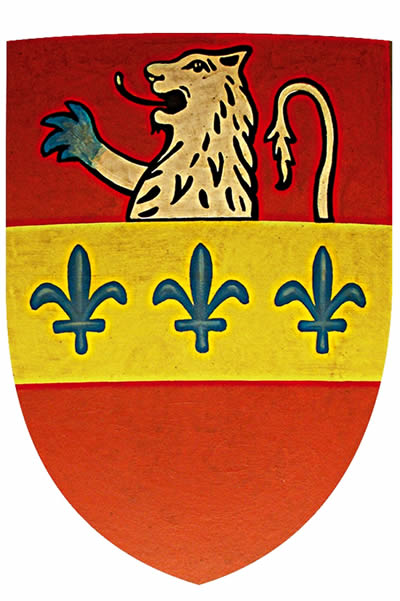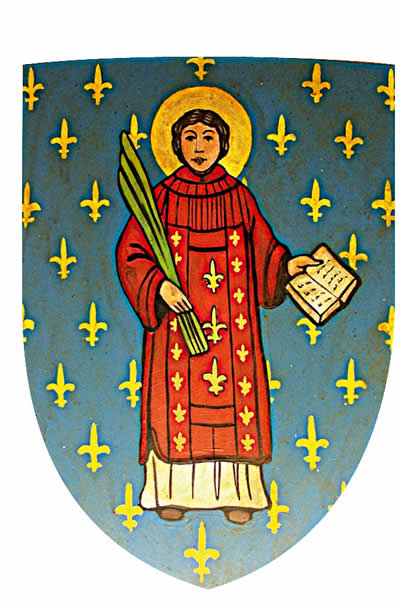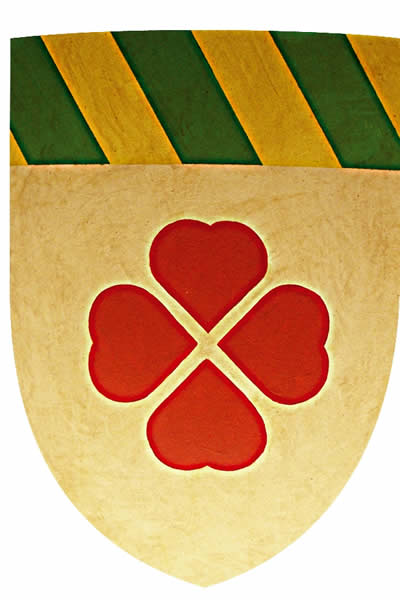AOC Location
Situated in the South of Burgundy, 10 kilometres West of Mâcon (Saone & Loire), the vineyards of Pouilly-Fuissé extend over a narrow stretch of land, covering 760 hectares. The AOC of Pouilly Fuissé is the biggest “communal” appellation in Burgundy (larger than Mercurey and Gevrey-Chambertin, for example).
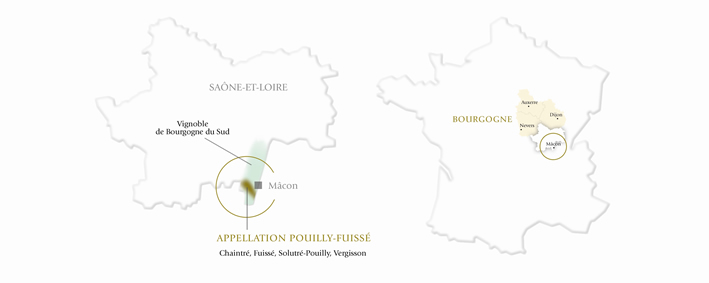
The villages of Chaintré, Fuissé, Solutré-Pouilly and Vergisson make-up the production area of the Pouilly-Fuissé appellation. Situated entirely on slopes, the unique grape variety of the appellation is Chardonnay, which produces rich wines, the style of which varies depending on whether the vines are grown on clay/marl or stony soils.
Symbolic of this AOC, the Rocks of Solutré and Vergisson have been looking down on us from 500 metres for 200 million years. 20,000 years ago this area was home to one of the most advanced civilisations of prehistoric times.
Revenir en haut
QUITE A STORY
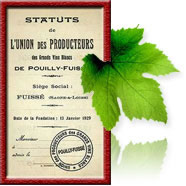 Founded in 1929, the Union des Producteurs of Pouilly-Fuissé is a syndicate that unites the producers of the Pouilly-Fuissé AOC (Appellation d'Origine Contrôlée).
Founded in 1929, the Union des Producteurs of Pouilly-Fuissé is a syndicate that unites the producers of the Pouilly-Fuissé AOC (Appellation d'Origine Contrôlée).
The Pouilly-Fuissé AOC is located in France’s Saône & Loire departement, at the southern edge of the Burgundy administrative and wine-producing region. Burgundy’s geological wine-producing area is made-up of sedimentary rock from the Jurassic period and runs from Chablis in the north, through the Côte d'Or, the Châlon area, and finishes in Pouilly-Fuissé in the south. In fact, a few kilometres south of the Pouilly-Fuissé appellation, the soils change to the volcanic granite soils of the Beaujolais region.
Only white wine is made in the Pouilly-Fuissé AOC and entirely from the Chardonnay grape. The appellation was first recognised by the Tribunal of Mâcon on the 17th of September 1922 and then by a decree passed on the 11th of September 1936. On the 29th of October 2009 a decree officially approved the appellation’s regulations.
In fact, the initial decree of 1936, as with the communal appellations of the Côte d'Or, allowed the specific vineyards to use their own production methods, when their names were added to that of the appellation.
The Pouilly-Fuissé appellation’s “Organisme de Défense et de Gestion” (ODG) (protection and control organisation) was officially recognised by the INAO in 2008. This organisation helps to preserve and develop the terroirs, the local traditions and the savoir-faire of the Pouilly-Fuissé AOC, as well as protecting and promoting the AOC as it deems necessary.
Revenir en haut
THE TERROIRS
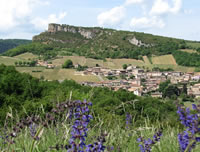 The geological make up of the Mâcon region is the result of the upthrust of the Alps, when the Bressan basin collapsed to the east and the Grosne basin to the west. The raised landscape that remained broke up into chains of hills running in a NNE-SSW direction with slopes on their eastern side.
The geological make up of the Mâcon region is the result of the upthrust of the Alps, when the Bressan basin collapsed to the east and the Grosne basin to the west. The raised landscape that remained broke up into chains of hills running in a NNE-SSW direction with slopes on their eastern side.
Erosion resulted in harder formations, and evacuated the soft material into the surrounding depressions. The result is a landscape of long parallel valleys, separated by crested asymmetrical hills: the east-facing slopes are generally fairly gentle; whereas the westerly slopes, are far steeper and sometimes form cliffs. This landscape has created a large variety of terroirs from a combination of geological substrata with the topography, and each area is characterised by its own soil type - a result of all these elements combined.
The Pouilly-Fuissé production area forms a gash cutting diagonally through the chains of hills at the southern edge of the Mâcon region.
A wide diversity of terroirs can therefore be found here, with varying exposures and on various substrata, mainly limestone-based.
Link to map
Revenir en haut
COLOURS AND GRAPE VARIETIES
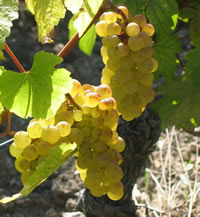 Only white wines are made here and from a single grape variety, the Chardonnay.
Only white wines are made here and from a single grape variety, the Chardonnay.
Revenir en haut
APPELLATION KEY FIGURES
Structure of Production
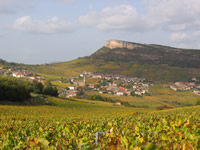 There are 420 producers in the Pouilly-Fuissé appellation spread over the 760 hectares in the appellation’s 4 districts: Chaintré, Fuissé, Solutré-Pouilly and Vergisson.
All types of farming arrangement are found within the appellation:
There are 420 producers in the Pouilly-Fuissé appellation spread over the 760 hectares in the appellation’s 4 districts: Chaintré, Fuissé, Solutré-Pouilly and Vergisson.
All types of farming arrangement are found within the appellation:
“faire-valoir direct” - owner/producer,
“bail à métayage” (sharecropping) - the owner gives a fixed proportion of the harvest to the farmer who cultivates the land, the most frequent arrangement is “à mi-fruit” where the harvest is shared equally (50%), and “à ferme”, a farming lease, where the farmer rents the land from the owner.
Below are figures for the 2008 harvest:
- Total declared surface area: 760 hectares
- Sharecropping: 228 hectares, 30%
- Owner/Producer and tenant farmers: 532 hectares, 70%
- Number of Owners who are not producers: 150
- Number of Producers: 270
- Average surface area of each producer: 2.80 hectares
- Number of producers with:
. Over 3 hectares: 88
. Over 5 hectares: 40
. Over 8 hectares: 17
It is difficult to ascertain the exact percentages of tenant farmers and owners/producers; however, looking at the trends over the last couple of years, we can see that these two methods of farming have increased spectacularly, taking over from the traditional “50% sharecropping” agreements.
The number of producers in the area may seem large compared to the appellation’s surface area but in fact over a hundred of these producers are members of the 4 cooperatives, with a total surface area of 53 hectares in 2008, i.e. 7% of the appellation. Only one of the cooperatives (in Chaintré) is situated within the AOC production area; the other 3 are situated nearby (in Prissé, Charnay-lès-Mâcon and Vinzelles). The Pouilly-Fuissé AOC can therefore be regarded has having the lowest percentage of land tied up with cooperatives in the Mâcon region (cooperatives generally represent over half of the production surface area in the Mâcon region).
Volumes and route to market
The maximum annual permitted yield in the last couple of years has been 60 hl/ha for the Pouilly-Fuissé appellation and 58 hl/ha when the name of a specific vineyard is added. From the 760 hectares of vineyards, a good harvest should produce around 45,000 hl. The average harvest over the last 10 years has been 42,970 hl.
The harvest is sold as follows:
- Sold in bulk to a négociant: 30,000 hl (66%)
- of which as grapes and must: 10,000 hl (22%)
- of which as wine (vin clair) 20,000 hl (44%)
- Sale of wine, bottled by producer: 15,000 hl (34%)
These figures have seen significant evolution in the last 20 years: sales in bottle from the property have almost doubled and continue to grow, while sales in bulk have seen the share of grapes and must sales, which only started in the early 90’s, now attain half of those of vin clair (wine that has gone through fermentation but not been blended or bottled). This evolution illustrates the wine houses’ (négociants) wish to control their stocks in terms of quantity as well as quality.
Of the 270 Pouilly-Fuissé winegrowers, 150 sell part of their production in bottle (including a minor or marginal proportion); and 50 of the 150 sell all, or the majority of their production, in bottle. This is a huge increase compared to the 70’s and 80’s when the figures for direct sales were not even half that number.
The Pouilly-Fuissé market:
The rapid growth of the Pouilly-Fuissé appellation after the Second World War was largely due to its increasing popularity in the U.S., the result of a marketing push by the big Burgundy wine houses who created the awareness and demand that Pouilly-Fuissé still enjoys today.
In 1957, Interprofession statistics showed that 126,628 bottles of Pouilly-Fuissé were exported to the USA, a little less than Chablis (149,812 bottles - not including the Premier and Grand Crus), and much more than Meursault (19,116 bottles), Macon white (9,744 bottles), or Gevrey-Chambertin (24,016 bottles).
Over the 80’s, Pouilly-Fuissé grew to become the most exported Burgundy appellation (in terms of % of its production). However it relied heavily on wine houses and the U.S. market, causing production prices to fluctuate significantly according to the strength of the Dollar. Exports to the U.S. reached their peak towards the end of the 80’s, with over 70% of Pouilly-Fuissé exported to this market (mainly by big wine houses, who are still the leading exporters to the U.S. today). Exports then slowed due to the increase of direct sales in bottle by the wine producers themselves and the diversification of export markets.
Today, comparing our internal data with that of the BIVB, we estimate:
Export: 75%, of which two thirds are sold to the U.S.
France: 25%, with around one third sold to supermarkets and two thirds sold in traditional channels (the On Trade – i.e. cafés, hotels, restaurants; wine stores; and direct to the public).
Pouilly-Fuissé is one of Burgundy's most exported appellations, but it is now diversifying its markets, away from the U.S., to other countries and regions, including the U.K., Benelux and Asia. Traditional industry channels continue to play an essential role in marketing the wines, with nearly 62% sold by wine houses, but the market is becoming more balanced (following trends seen in other Burgundy appellations).
Revenir en haut
AN APPELLATION WITH CHARACTER, TO BE ENJOYED WITH…
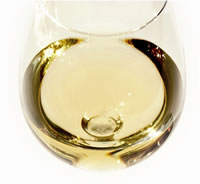 Elegant and full of charm, these white wines display a pale to deep gold hue with green highlights. Different families of aromas make up the bouquet: light mineral aromas (flint), almond and hazelnut, citrus fruit (lemon, grapefruit, pineapple), white fruit (peach), linden tree and acacia, bread crumbs, butter brioche and honey.
Elegant and full of charm, these white wines display a pale to deep gold hue with green highlights. Different families of aromas make up the bouquet: light mineral aromas (flint), almond and hazelnut, citrus fruit (lemon, grapefruit, pineapple), white fruit (peach), linden tree and acacia, bread crumbs, butter brioche and honey.
The different terroirs offer a diverse array of flavours on the palate. The wines have an opulent style and firm structure helped by their natural richness. These are wines of distinction and finesse.
Rich and complex, the wine has a mineral touch which makes it especially good with top quality crustaceans, prawns, lobsters, crayfish, as well as cooked fois gras. Its lovely balance of acidity and suppleness makes it a good match with white meats, such as veal, chicken or turkey in a creamy sauce, and of course with goat’s cheese. Its aromatic power ensures it can also pair well with spicy and very fragrant exotic dishes, such as coucous, fish tajines, or sweet and sour prawns. The wine’s mineral flavours make it perfect with sushi.
Serving temperature: between 11 - 13°C
Revenir en haut
THE HERITAGE OF THE APPELLATION
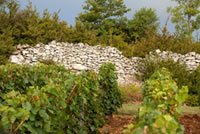 The Pouilly-Fuissé appellation is distinguished by its exceptional site: the Rocks of Solutré and Vergisson are world famous, with their 495 metre high, rocky outcrops of Bajacian limestone. This area has been classified a "Grand Sites de France" and as such is protected.
The Pouilly-Fuissé appellation is distinguished by its exceptional site: the Rocks of Solutré and Vergisson are world famous, with their 495 metre high, rocky outcrops of Bajacian limestone. This area has been classified a "Grand Sites de France" and as such is protected.
Solutré is an important prehistoric site; 'Solutrean' is the name given to the upper Palaeolithic prehistoric period (20,000 years ago), the most advanced period of the Stone Age (an enormous number of Palaeolithic tools and several tens of thousands of horse remains were found at the foot of the rock).

Revenir en haut
THE BEGINNINGS OF THE APPELLATION
Pouilly-Fuissé: Status of the application for Premiers Crus recognition
By pure bad luck, during the Second World War, Pouilly-Fuissé was the only great Burgundy appellation not to be granted a hierarchical system of Premier Crus for its best vineyards. The continuous improvement in the quality of these vineyards, unanimously recognized as being on a par with many of the best white Burgundies, prompted the Union des Producteurs de Pouilly-Fuissé (Pouilly-Fuissé producers’ syndicate) to start to take steps in 2007 to obtain Premier Cru recognition.
Contrary to popular belief, Premiers Crus did not feature in the communal appellation regulations throughout Burgundy in the 30’s. The regulations (including those of Pouilly-Fuissé) only permitted a certain number of specific vineyards to add their name to the appellation (this practice was different from that of Grand Crus, where the name of the appellation and the specific vineyard were one and the same). Certain laws specified which vineyard names could be used and other laws left this for future committees to determine.
In 1942 a law was passed allowing only those crus which were officially recognized to legally use the term "Premier Cru". This law was prompted by tax reasons and requisition demands by the occupying forces. A commission made-up of “uncontested personalities” drew up this list. As this had to be done quickly, the list was largely inspired by the "Premières Cuvées" that featured in the 1861 plan, along with some additions made by prominent, local figures. A law was finally passed on the 14th of October 1943, and the AOC’s official premiers crus were thereby established. (Taken from the work of Jean-François BAZIN "Histoire des vins de Bourgogne" Published by JP Gisserot 17/07/2002).
It should not be forgotten that at this period in the time, the line separating Free France (in the south) and occupied France (in the north) ran just south of Châlon sur Saône. The vineyards of the Châlon area and the Côte d'Or were in the occupied zone whereas the Mâcon region was the only part of Burgundy in the Free Zone.
Up until that time the use of the name of the best vineyard sites had been normal practice in Pouilly-Fuissé, as in the Côte d'Or, so it was, in fact, the Second World War which isolated Pouilly-Fuissé from the other Burgundy AOCs.
After the war, there were other, more pressing concerns, and the production structure in the Mâcon region developed independently to that of the Côte d'Or, until gradually the cultural gap of the hierarchical system became irreparable. The AOC had to wait more than half a century, until the Macon AOCs returned to prominence and the wine producers took the region's future into their own hands, before trying to correct this historical error.
In 2007, Pouilly-Fuissé, in close collaboration with the INAO in Burgundy, embarked on the long-term endeavour of compiling an application that was as complete as possible. In 2008, a detailed study of the appellation’s soils was carried-out by the SIGALES firm. The study resulted in the publication of an accurate and detailed map. This was a very important stage in the project and was completed in 2009 by a further study of the vineyard parcels with the producers, which brought out other important factors (reputation and history of the specific vineyards, bibliography, topography, toponymy, anthropization, economy, cultural practices, etc)
In March 2010, the application was officially filed with the INAO. It included a list of specific vineyards requesting premier cru status and proposed production regulations for these premiers crus. In May 2010, the Regional Committee of the INAO, responded favourably to Pouilly-Fuissé’s request and in November the National Committee called for a Commission of Inquiry.
Made up of 7 members, professionals from other regions, the Commission visited Pouilly-Fuissé on 3 occasions in 2011 to assess the validity of the request, and to agree the criteria that would be used to examine the application.
The Commission of Inquiry recognised the high quality level of the wines and declared Pouilly-Fuissé’s application to be valid. The Commission will now request the appointment of a panel of consultants and experts to undertake the field work necessary to determine the criteria for delimitation of the premiers crus and the delimitation itself. We estimate that it will take a further 3 or 4 years to complete the application.
The producers of Pouilly-Fuissé, whose high quality wines are recognised the world over, eagerly await confirmation that their A.O.C.’s status will be restored to the same level as that of the Côte Chalonnaise, Côte d'Or and Chablis, the other regions in Burgundy which have long benefited from the prestige of having a Premiers Crus, and sometimes even Grands Crus, hierarchical classification for their appellations.
F.M BURRIER
President
Union des Producteurs de Pouilly-Fuissé
Revenir en haut


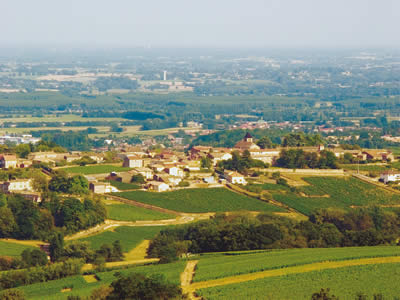
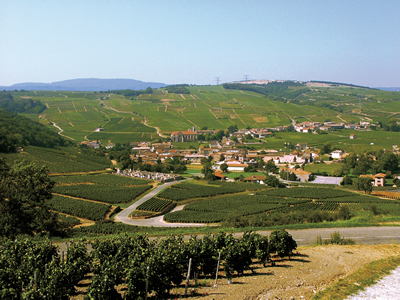
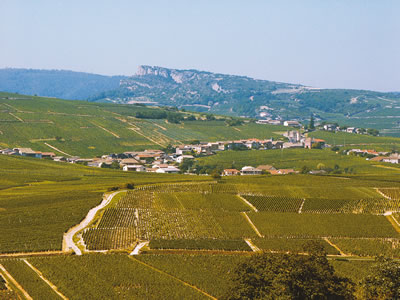
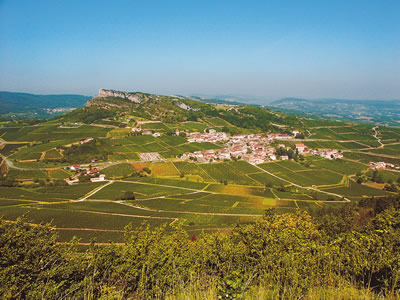
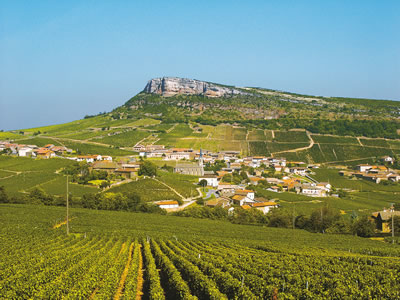
 Founded in 1929, the Union des Producteurs of Pouilly-Fuissé is a syndicate that unites the producers of the Pouilly-Fuissé AOC (Appellation d'Origine Contrôlée).
Founded in 1929, the Union des Producteurs of Pouilly-Fuissé is a syndicate that unites the producers of the Pouilly-Fuissé AOC (Appellation d'Origine Contrôlée).
 The geological make up of the Mâcon region is the result of the upthrust of the Alps, when the Bressan basin collapsed to the east and the Grosne basin to the west. The raised landscape that remained broke up into chains of hills running in a NNE-SSW direction with slopes on their eastern side.
The geological make up of the Mâcon region is the result of the upthrust of the Alps, when the Bressan basin collapsed to the east and the Grosne basin to the west. The raised landscape that remained broke up into chains of hills running in a NNE-SSW direction with slopes on their eastern side.
 Only white wines are made here and from a single grape variety, the Chardonnay.
Only white wines are made here and from a single grape variety, the Chardonnay.
 There are 420 producers in the Pouilly-Fuissé appellation spread over the 760 hectares in the appellation’s 4 districts: Chaintré, Fuissé, Solutré-Pouilly and Vergisson.
All types of farming arrangement are found within the appellation:
There are 420 producers in the Pouilly-Fuissé appellation spread over the 760 hectares in the appellation’s 4 districts: Chaintré, Fuissé, Solutré-Pouilly and Vergisson.
All types of farming arrangement are found within the appellation: Elegant and full of charm, these white wines display a pale to deep gold hue with green highlights. Different families of aromas make up the bouquet: light mineral aromas (flint), almond and hazelnut, citrus fruit (lemon, grapefruit, pineapple), white fruit (peach), linden tree and acacia, bread crumbs, butter brioche and honey.
Elegant and full of charm, these white wines display a pale to deep gold hue with green highlights. Different families of aromas make up the bouquet: light mineral aromas (flint), almond and hazelnut, citrus fruit (lemon, grapefruit, pineapple), white fruit (peach), linden tree and acacia, bread crumbs, butter brioche and honey.  The Pouilly-Fuissé appellation is distinguished by its exceptional site: the Rocks of Solutré and Vergisson are world famous, with their 495 metre high, rocky outcrops of Bajacian limestone. This area has been classified a "Grand Sites de France" and as such is protected.
The Pouilly-Fuissé appellation is distinguished by its exceptional site: the Rocks of Solutré and Vergisson are world famous, with their 495 metre high, rocky outcrops of Bajacian limestone. This area has been classified a "Grand Sites de France" and as such is protected.
